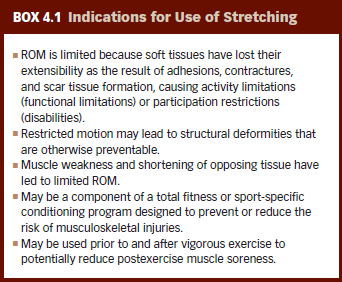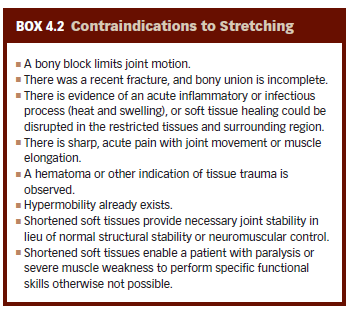yk like wh when wha huh
1/138
Earn XP
Description and Tags
yeah woa h
Name | Mastery | Learn | Test | Matching | Spaced |
|---|
No study sessions yet.
139 Terms
Mobility can be described based on two different but interrelated parameters: _____ + ____
Functional ROM
Functional Mobility
Ability of structures or segments of the body to move or be moved to allow the presence of range of motion for functional activities
Functional ROM
Ability of an individual to initiate, control, or sustain active movements of the body to perform simple to complex motor skills
functional mobility
True/False: The ROM needed for performance of functional activities does not necessarily mean full or normal ROM
True
Sufficient mobility of soft tissues and ROM of joints must be supported by a requisite level of _______
muscle strength and endurance, and neuromuscular control
Caused by adaptive shortening of soft tissues as a result or disorders or situations
Hypomobility
Factors that contribute to Hypomobility
Prolonged immobilization of a body segment
Sedentary lifestyle
Postural malalignment and muscle imbalances
Impaired muscle performance
Tissue Trauma
Congenital or acquired deformities
hypomobility can result to _______ and ______ in a person’s life
activity limitations and participation restriction
Ability to move a single joint or series of joints smoothly and easily through an unrestricted, pain-free ROM
Flexibility
Dynamic Flexibility is AKA
Active mobility or Active ROM
Dependent on the degree to which a joint can be moved by a muscle contraction and the amount of tissue resistance met during the active movement
Dynamic Flexibility
Passive Flexibility is AKA
Passive mobility or Passive ROM
Passive Flexibility is dependent on?
Extensibility of muscles and connective tissues that cross and surround a joint
This type of flexibility is a prerequisite for the other type of flexibility
Passive flexibility is a prerequisite for dynamic flexibility
Adaptive shortening of the muscle-tendon unit and other soft tissues that cross or surround a joint resulting in significant resistance to passive or active and limitation of ROM
Contracture
Term used to denote partial loss of motion
Shortness
This term is discouraged to describe restricted motion due to adaptive shortening of soft tissue
Tightness
If a patient has shortened elbow flexors and cannot fully extend the elbow, he is said to have an __________ contracture
elbow flexion contracture
In this type of contracture, there is musculotendinous unit shortening and significant loss of ROM, but there is no specific muscle pathology
Myostatic contracture
In myostatic contracture, there is a reduction in the number of _________
sarcomere units
True/False: There is no decrease in sarcomere length in myostatic contracture
True
True/False: It takes a considerable amount of time to resolve myostatic contractures with stretching exercises
False; Relatively short time
Type of contracture where the muscles appear t be in a constant state of contraction; Due to hypertonicity associated with CNS lesion
Pseudomyostatic contracture
Procedures to reduce muscle tension temporarily are applied, full, passive elongation of the apparently shortened muscle is then possible for those with pseudomyostatic contracture
Neuromuscular inhibition procedures
Contracture resulting from intra-articular pathology
Arthrogenic Contacture
This type of contracture develops when connective tissues that cross or attach to a joint or the joint capsule lose mobility, thus restricting normal arthrokinematic motion
Periarticular Contracture
Contracture resulting from fibrous changes in the connective tissue of muscle and periarticular structure causing adherence of these tissues
Fibrotic Contracture
True/False: It is difficult to re-establish optimal tissue length for those with fibrotic contracture
True
The longer a ________ contracture exists, the more difficult it becomes to regain optimal mobility of soft tissues
Fibrotic contracture or greater replacement of normal muscle and connective tissue with nonextensible adhesions and scar tissue or bone
Applying stretching techniques selectively to some muscles and joints but allowing limitation of motion to develop in other muscles or joints
Selective Stretching
Selective Stretching is typically used in patients with _______
permanent paralysis (ex. SCI patients)
Stretch well beyond the normal length of muscle and ROM of a joint and the surrounding soft tissues
Overstretching
True/False: Creating selective hypermobility by overstretching may be necessary for certain healthy individuals
True
instability of a joint often causes ______ and may predispose a person to __________
pain → musculoskeletal injury
Type of stretching where a sustained or intermittent external, end-range stretch force, applied with overpressure and by manual contact or a mechanical device
Manual or Mechanical / Passive or Assisted
Any stretching exercise that is carried out independently by a patient after instruction and supervision by a therapist
Self-Stretching
Procedures purported to relax tension in shortened muscles reflexively prior to or during muscle elongation
Neuromuscular Facilitation and Inhibition
Other terms for Neuromuscular Facilitation and Inhibition procedures
PNF stretching, active inhibition, active stretching, or facilitated stretching
Procedures that employ a voluntary muscle contraction by the patient in a precisely controlled direction and intensity against a counterforce applied by the practitioner
Muscle energy techniques
Other term for Muscle Energy Techniques
Postisometric Relaxation
Skilled manual therapy interventions applied to joint structures to modulate pain and treat joint impairments that limit ROM
Joint Mobilization / Manipulation
Techniques designed to improve muscle extensibility and involves the application of specific and progressive manual forces
Soft Tissue Mobilization / Manipulation
Indications for Use of Stretching

Contraindications to Stretching

Primary effect and expected outcome of a program of stretching exercise
Increased Flexibility and ROM
True/False: Acute Stretching increases muscle performance immediately following the stretching session
False
This approach to stretching has been found to improve strength or power
Chronic Stretching
program of stretching exercises performed on a regular basis over a period of weeks
Chronic Stretching
The ability of the body to move freely with control during functional activities is dependent on _______ + _________
on the passive extensibility of soft tissues as well as active neuromuscular control.
Primary cause of restricted ROM in both healthy individuals an patients with impaired mobility
Decreased extensibility of connective tissue (NOT contractile elements of muscle tissue)
ability of soft tissue to return to its prestretch resting length directly after a short-duration stretch force has been removed
Elasticity
time-dependent property of soft tissue that initially resists deformation, such as a change in length, of the tissue when a stretch force is first applied
Viscoelasticity
allows a change in the length of the tissue and then enables the tissue to return gradually to its prestretch state after the stretch force has been removed
Viscoelasticity
the tendency of soft tissue to assume a new and greater length after the stretch force has been removed
Plasticity
Act as the harness of a muscless
Connective tissue structures - Endomysium → Perimysium → epimysium
primary source of a muscle’s resistance to passive elongation.
Connective tissue framework of muscle
When contractures develop, adhesions in and between _______ resist and restrict movement
collagen fibers
Response of Muscle to Passive Stretch
Initial Lengthening: occurs in series elastic component (connective tissue) - Tension rises sharply
Mechanical Disruption: filaments slide apart - sarcomere give
Release: Sarcomeres return to their resting length
Muscle Morphological changes as a response to Immobilization and remobilization
decay of contractile protein in the immobilized muscle
decreases in muscle fiber diameter the number of
myofibrils, and intramuscular capillary density
increase in fibrous and fatty tissue in muscle also occurs
Atrophy occurs more quickly and more extensively in this type of muscle
Slow Twitch (postural muscles)
when a muscle is immobilized in a shortened position for several weeks, which is often necessary after a fracture or surgical repair of a muscle tear or tendon rupture, there is a _________
Reduction in the length of the muscle and its fibers and in the number of sarcomeres in series with myofibrils as the result of sarcomere absorption
True/False: Muscle immobilized in a shortened position atrophies and weakens at a faster rate than if it is held in a lengthened position
True
There is a shift to the _____ in the length-tension curve of a shortened muscle
Left
increasing the number of sarcomeres in series
Myofibrillogenesis
True/False: The adaptation of the contractile units of muscle to prolonged positioning in either lengthened or shortened positions is permanent
False
major sensory organ of muscle and is sensitive to quick and sustained (tonic) stretch
Muscle Spindle
Muscle spindle is sensitive to ________
quick and sustained tonic stretch
The main function of muscle spindles is to receive and convey information about
changes in the length of a muscle and the velocity of the length changes
Which part of an intrafusal fiber is contractile
Polar regions (not equatorial region)
These innervate the contractile polar regions of intrafusal muscle fibers
Gamma motor neurons - adjust the sensitivity of muscle spindles
These neurons innervate the extrafusal fibers
Alpha motor neurons
Two general types of intrafusal fibers
Nuclear bag fibers
Nuclear chain fibers
arise from nuclear bag fibers, sense and cause muscle to respond to
both quick and sustained (tonic) stretch
Primary afferent endings (type Ia fiber)
Fibers that are from the nuclear chain fibers which are sensitive only to tonic stretch
Type II
sensory organ located near the musculotendinous junctions of extrafusal muscle fibers.
Golgi Tendon Organ
Function GTO
Monitor changes in tension of muscle-tendon units
GTO are sensitive to slight changes of tension on a muscle-tendon unit as a result of _________ or __________
passive stretch of a muscle or with active muscle contractions during normal movement
Effect of GTO
inhibits alpha motoneuron activity → decreases tension in
the muscle-tendon unit being stretched
True/False: GTO has a low threshold for firing
True
How is the stretch reflex minimized during stretching procedures?
slowly applied, low-intensity, prolonged stretch is considered preferable to a quickly applied, short-duration stretch.
GTO causes ______ inhibition
autogenic
Muscle Spindle causes ______ inhibition
Reciprocal
Connective tissue is composed of three types of fibers:
Collagen, elastin, reticulin, and nonfibrous ground substance
responsible for the strength and stiffness of tissue and resist tensile deformation
Collagen Fibers
These form the building blocks of collagen microfibrils
Tropocollagen crystals
The fibers of tendons and ligaments mostly contain _____ collagen
Type I collagen - highly resistant to tension
______ fibers provide extensibility
Elastin
_____ fibers provide tissue with bulk
reticulin
an organic gel containing water that reduces friction between fibers, transports nutrients and metabolites, and may help prevent excessive cross-linking between fibers by maintaining space between fiber
Ground Substance
structural element that absorbs most of the tensile stress.
Collagen
Mechanical Behavior of Collagen
elongate quickly under light loads (wavy fibers align and straighten)
With increased loads, tension in the fibers increases, and the fibers stiffen
Alignment of collagen fibers in tendons
Parallel = resist the greatest tensile load
Alignment of collagen gibers in skin
Random = weakest in resisting tension
Alignment of collagen fibers in ligaments, joint capsules, fascia
Vary between parallel and random = resist multidirectional forces
internal reaction or resistance to an external load
Mechanical Stress
Amount of deformation or lengthening that occurs when a load is applied
Strain
Force applied perpendicular to the cross-sectional area of the tissue in a direction away from the tissue
Tension
A stretching force is a ____ stress
tension stress
force applied perpendicular to the cross sectional area of the tissue in a direction toward the tissue.
Compression
Force applied parallel to the cross-sectional area of the tissue
Shear